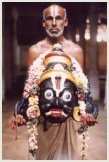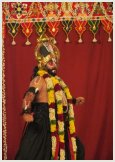 |
 |
 |
 |
 |
 |
 |
 |
| Home | Kaisiki Natakam | Project Kaushal Arayer Sevai Monuments crumble, manuscripts get moth eaten and traditional fine arts practised for centuries in temples are being forgotten because of long years of neglect. No wonder that the Arayer Sevai, a visual enactment of the passionate expression by Vaishnavite saints which were an integral part of Vishnu worship 1000 years ago, is not confined to a handful of practitioners who themselves are on the threshold of fading away.  Who
were the arayers? What makes this dramatic form so unusual in the
landscape
of Indian performance, ritual, religion and theology? The word arayer
itself means
king. In Tamil, there are two ways to pronounce the letter 'r'. Said
without stress
like 'arayer' it means king and with stress like 'rr' it means 'speaker'
or 'narrator'.
In both cases the word fits these temple servants who dedicated their
lives
towards the worship and glory of Lord Vishnu through song, dance and
drama.
Vaishnavite temples were the crucibles of the three branches of learning
'iyal' (literature), 'isai' (music) and 'natakam' (drama).
Arayer Sevai which means 'the service or offering of the royal priests'
falls under the category of drama. Who
were the arayers? What makes this dramatic form so unusual in the
landscape
of Indian performance, ritual, religion and theology? The word arayer
itself means
king. In Tamil, there are two ways to pronounce the letter 'r'. Said
without stress
like 'arayer' it means king and with stress like 'rr' it means 'speaker'
or 'narrator'.
In both cases the word fits these temple servants who dedicated their
lives
towards the worship and glory of Lord Vishnu through song, dance and
drama.
Vaishnavite temples were the crucibles of the three branches of learning
'iyal' (literature), 'isai' (music) and 'natakam' (drama).
Arayer Sevai which means 'the service or offering of the royal priests'
falls under the category of drama.
The main text for these priestly actors was an impressive volume of verses called the 'Divya Prabandham.' The word means 'divine compilation.' The Prabandham was the cumulative result of 12 saint-poets who lived between the 6th and 9th centuries in Tamil country. These saint-poets were called 'alwars'. The word 'alwar' means 'deepest of the deep'; one who is immersed in the devotion of Lord Vishnu/Narayana.  Between
the 6th and 9th century, in the Tamil speaking region of South India,
these devotees of Vishnu (also known as Tirumal, the
dark one) changed and revitalized Hinduism. Along with their
counterparts, the Nayanmars, who were devotees of Siva, these
saint-poets wandered all over the Tamil countryside, inspiring and
converting kings, brahmans, and peasants, affirming in poetry
the holiness of hundreds of Tamil places dedicated to Vishnu and Siva.
Their pilgrimages, their legends and their hymns, which they
sang by the thousands literally mapped a sacred geography of the Tamil
regions and fashioned a communal self-image that cut
across class and caste. They composed the most important early Bhakti
poetry in any Indian language. This is particularly
significant when practitioners of dance, dance history and religious
studies have a tendency to associate Bhakti/devotional poetry
with the later poets like Jayadeva of the 12th century, Chaitanya in
Bengal of the 15th century and Annamaya of the 14th century.
Even Tulsidas, Kabir, Meera who are popular choices for dancers and
singers came much later. Between
the 6th and 9th century, in the Tamil speaking region of South India,
these devotees of Vishnu (also known as Tirumal, the
dark one) changed and revitalized Hinduism. Along with their
counterparts, the Nayanmars, who were devotees of Siva, these
saint-poets wandered all over the Tamil countryside, inspiring and
converting kings, brahmans, and peasants, affirming in poetry
the holiness of hundreds of Tamil places dedicated to Vishnu and Siva.
Their pilgrimages, their legends and their hymns, which they
sang by the thousands literally mapped a sacred geography of the Tamil
regions and fashioned a communal self-image that cut
across class and caste. They composed the most important early Bhakti
poetry in any Indian language. This is particularly
significant when practitioners of dance, dance history and religious
studies have a tendency to associate Bhakti/devotional poetry
with the later poets like Jayadeva of the 12th century, Chaitanya in
Bengal of the 15th century and Annamaya of the 14th century.
Even Tulsidas, Kabir, Meera who are popular choices for dancers and
singers came much later.
Through the poetry of the Prabandham, composed by these 12 Tamil alwars Hindu philosophy spoke for the first time in India, in a language other than Sanskrit. The imperial presence of Sanskrit with its brahminical texts like the Vedas and the Upanishads was the elitist presence against which Bhakti in Tamil defined itself. Also Sanskrit in India of the 6th century was not a people's language, it was not spoken as everyday tongue. Here was poetry, devotional poetry in a people's first language. The concept of bhakti or devotional poetry as we understand today arose, as suggested by scholars from the meshing of Sanskrit mythology and the Tamil conception of women and kings.  Almost one thousand years after all the 4000 verses of the Prabandham were
composed, a devotee called Natamuni (10th century) gathered and ordered the
compositions of the 12 alwars and arranged for their recitation. First he only knew
of 10 poems and when he realised there were almost 4000, he travelled to the
birthplace of Nammalwar (Alwartirunagari near Tirunelveli) and tried to retrieve
them. Failing to do so, he meditated and received a vision of the poet Nammalwar
himself who revealed all the 1102 verses to him. Almost one thousand years after all the 4000 verses of the Prabandham were
composed, a devotee called Natamuni (10th century) gathered and ordered the
compositions of the 12 alwars and arranged for their recitation. First he only knew
of 10 poems and when he realised there were almost 4000, he travelled to the
birthplace of Nammalwar (Alwartirunagari near Tirunelveli) and tried to retrieve
them. Failing to do so, he meditated and received a vision of the poet Nammalwar
himself who revealed all the 1102 verses to him.
Legend goes that he received all the 4000 verses in this way. In order to make the poetry meaningful and alive to the general public, Natamuni arranged for them to be sung and danced on special occasions of Lord Vishnu, particularly in the month of Margazhi which is mid-December to mid-January and in Panguni Chitra which is mid-March to mid-April the end of which marks the Tamil New Year on 14th April. Believing that the songs would live only if many could chant and watch the most special poems danced with gestures and movements, Natamuni is credited to have created a system of ritual performance called Arayer Sevai. The word Arayer literally means Lord or King. The Arayers of today are all direct descendants of Natamuni's family lineage and the practice is held with the male members of the family and not taught to the women. It is devoutly believed that the inspiration for the music and the dance came from Lord Vishnu himself and that it was He who ordained these arayers to perform this unique service for His pleasure. The movement structure of Arayer Sevai is dependent on a regal stature, a stately walk and minute right hand and left hand gestures which weave a complex imagery. The end of every phrase or sentence is marked by a jerky flick of the hand. The feet stamp the ground and the legs are always held in a unique half seated stance. The costume worn by the arayers consists of a cap which is a reproduction of the crown worn by Vishnu as the temple idol. The garland and the cymbals the arayers carry were all believed to have been given by Vishnu himself.  The arayers were exalted in the hierarchy of temples. They were as important and sometimes even more highly regarded than the priests themselves. Palm leaf manuscripts of temples like Srirangam and Srivilliputur, state that the arayers were given special treatment and medical care whenever they fell ill. Today all Vishnu temples have the bronze images of the 12 alwars as important figures in their shrines but the art of 'arayer' exists only in four temples, three in Tamilnadu and one in Karnataka. Melkottai in Karnataka does not perform the movements and actions but only the recitation and chanting and commentary. The three temples in Tamilnadu are Srirangam, Alwar Tirunagari and Srivilliputtur. The insistence on maintaining the purity of their tradition is not augmented with a desire to perfect the art of their ancestors rather than just going through the motions once or twice a year. They refuse to teach, allow audio or video recordings of their ritual and thus it will be but a matter of time when the practice which is already a mere shadow of its former self is completely lost. I was able to watch several hours of their performance since I was considered a direct Vaishnav descendent of one of the famous families of Thirukurungudi (the town of the famous arayer temple bell) and as such allowing me to watch or allowing me to learn some of their movements was not considered sacreligious to the high priest. If you want to help in any way please contact us: arangham@gmail.com Legends of the Araiyars, custodians of an ancient Vaishnavite art form An ancient performing arts tradition is in dire need of help Veejay Sai, The News Minute, February 21, 2016 http://www.thenewsminute.com/.... |